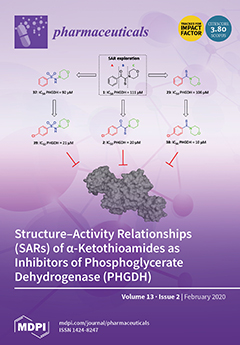The neglected tropical disease, schistosomiasis, is caused by trematode blood flukes of the
Schistosoma genus and infects approximately 200 million people worldwide. With just one partially effective drug available for disease treatment, new drugs are urgently needed. Herein, a series of 47 phthalimide
[...] Read more.
The neglected tropical disease, schistosomiasis, is caused by trematode blood flukes of the
Schistosoma genus and infects approximately 200 million people worldwide. With just one partially effective drug available for disease treatment, new drugs are urgently needed. Herein, a series of 47 phthalimide (Pht) analogues possessing high-value bioactive scaffolds (i.e., benzimidazole and 1,2,3,-triazoles) was synthesized by click-chemistry. Compounds were evaluated for anti-schistosomal activity in culture against somules (post-infective larvae) and adults of
Schistosoma mansoni, their predicted ADME (absorption, distribution, metabolism, and excretion) properties, and toxicity vs. HepG2 cells. The majority showed favorable parameters for surface area, lipophilicity, bioavailability and Lipinski score. Thirteen compounds were active at 10 µM against both somules and adults (
6d,
6f,
6i–
6l,
6n–
6p,
6s,
6r’,
6t’ and
6w). Against somules, the majority caused degeneracy and/or death after 72 h; whereas against adult parasites, five compounds (
6l,
6d,
6f,
6r’ and
6s) elicited degeneracy, tegumental (surface) damage and/or death. Strongest potency against both developmental stages was recorded for compounds possessing
n-butyl or isobutyl as a linker, and a pentafluorophenyl group on triazole. Apart from five compounds for which anti-parasite activity tracked with toxicity to HepG2 cells, there was apparently no toxicity to HepG2 cells (EC
50 values ≥50 µM). The data overall suggest that phthaloyl-triazole compounds are favorable synthons for additional studies as anti-schistosomals.
Full article






